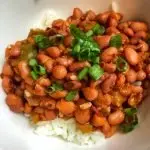I have only been to New Orleans once, but that is all it took to fall in love with the city. I loved the art, culture and of course, the FOOD! My first experience with red beans and rice was in New Orleans. Of course, this was not vegetarian red beans and rice, but it inspired this recipe!
Traditional Cajun/Creole food is known for being flavorful and hearty. With small modifications, much of this food can be made kidney friendly! Vegetarian red beans and rice is a great example of modifying a traditional recipe and making it a healthy option.
Flavor Without The Meat
Red beans and rice traditionally gets it’s scrumptious, smoky flavor from meat. Generally salt pork, andouille sausage or tasso ham is added. Unfortunately, these ingredients add quite a bit of salt. To keep the dish low sodium, I avoided using these ingredients.
Instead, the smoky flavor in this dish comes from chipotles in adobo. Usually used in Mexican cooking, these canned chiles add a ginormous flavor punch. Beware, they are incredibly spicy. You can use more for your vegetarian red beans and rice if you like, but be careful of the spice. A little goes a long way!
Smoked paprika also gives these red beans and rice a ton of flavor. Make sure to use smoked paprika, as traditional or sweet Hungarian-style paprika will not give us the same flavor profile. Save the sweet paprika for chicken paprikash!
The green onion garnish and splash of red wine vinegar also provide a ton of fresh flavor to this dish!
White vs. Brown Rice
For most people, brown rice is a healthier choice. Brown rice has more fiber than white rice (1.5g of fiber in brown rice vs. 0.3g in white rice per 1/2 cup cooked rice). I chose to use white rice in this recipe because I personally just love the fluffy texture of white rice in this dish. However, you can absolutely use brown rice if you want that extra fiber. It is up to you!
Brown rice also has more potassium and phosphorus in it. However, the extra potassium is not a concern for many people with kidney disease, and the extra phosphorus isn’t very well absorbed.
Hot Sauce for Vegetarian Red Beans and Rice
If you are like me, you can’t have red beans and rice without hot sauce! Louisiana hot sauce happens to be my favorite. Be aware of how much sodium is in the hot sauce that you use. It can add up quickly!
This recipe only has 394mg of sodium, or about 20% of your daily sodium goal. Likely leaving some room for a dash of hot sauce.
Happy Eating!
Melanie
Vegetarian Red Beans and Rice
Ingredients
- 1 lb small dried red beans picked over & rinsed
- 3 tbsp unsalted butter
- 1 onion chopped fine
- 1 green bell pepper chopped fine
- 2 celery stalks chopped fine
- 3/4 tsp salt
- 4 cloves garlic chopped
- 2 chipotles in adobo sauce chopped fine
- 2 tsp smoked paprika
- 2 tsp dried thyme
- 2 bay leaves
- 1/8 tsp cayenne pepper
- 1/2 tsp black pepper
- 1 tbsp red wine vinegar
- 1 bunch green onions chopped
- 2 cups white rice dry
Instructions
- Soak the beans overnight. Combine dried beans with 2 quarts (8 cups) of water. Let soak at least 12 hours and up to 24 hours. Rinse beans.
- Melt butter in Dutch oven or large soup pot. Add onion, bell pepper, celery and 1/2 teaspoon salt. Cook until vegetables are soft, about 7 minutes.
- Add garlic, chipotles, paprika, thyme, bay leaves, cayenne and black pepper. Cook until fragrant, about 30 seconds.
- Add beans and 9 cups of water. Bring to a boil. Reduce heat to a vigorous simmer and cook until liquid begins to thicken, about 45 minutes.
- Add vinegar and remaining 1/4 teaspoon salt. Continue to simmer until thickened and creamy, about 30 more minutes.
- Meanwhile, cook rice according to package instructions. Do not add salt, butter or oil for the nutrition information to match what is listed below.
- Serve 1/2 cup beans over 1/2 cup cooked rice. Serve with plenty of green onion!



Using red kidney beans instead of the small red beans would lower the oxalate content, which is better for most kidney-conscious eaters! My resource shows that the oxalate content in a half cup serving of kidney beans is only 12.37 mg compared to 23.66 mg for small red beans. That substitution could almost halve the oxalate burden, with minimal aesthetic changes in the dish!
Hi Karen! Thank you so much for your comment! Yes, kidney beans are slightly lower in oxalate than red beans. However, I don’t recommend a low oxalate diet for everyone (here is an article on my low oxalate diet recommendations). And, even people who do need to restrict oxalate can usually safely eat 100-200mg oxalate per day (along with adequate calcium!) to bring urine oxalate down to safe ranges. In this context, I figured the 10ish mg difference in oxalate was minimal and opted for the traditional red bean for this recipe. BUT, some people (VERY few!) need to be super conscious of oxalate – in this case, kidney beans would absolutely work here. Thanks for pointing this out!
This recipe suitable for pkd patients ?
Absolutely! This is a WONDERFUL plant based recipe for people with PKD!